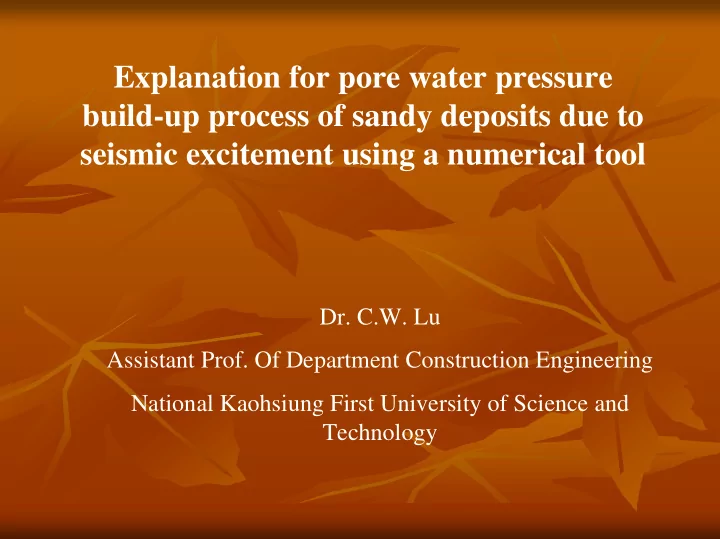

Explanation for pore water pressure build-up process of sandy deposits due to seismic excitement using a numerical tool Dr. C.W. Lu Assistant Prof. Of Department Construction Engineering National Kaohsiung First University of Science and Technology
Stress is a tensor which can be represented by a matrix in Cartesian coordinates: According to Terzaghi's principle, stresses in the soil are divided into effective stresses, σ ' , and pore pressures, σ w :
Material models for soil and rock are generally expressed as a relationship between infinitesimal increments of effective stress and infinitesimal increments of strain. In such a relationship, infinitesimal increments of effective stress are represented by stress rates (with a dot above the stress symbol):
Strain is a tensor which can be represented by a matrix with Cartesian coordinates as: According to the small deformation theory, only the sum of complementing Cartesian shear strain components ε ij and ε ji result in shear stress. This sum is denoted as the shear strain γ . Hence, instead of ε xy , ε yx , ε yz , ε zy , ε zx and ε xz the shear strain components γ xy , γ yz and γ zx are used respectively.
In analogy to the invariants of stress, it is also useful to define invariants of strain. A strain invariant that is often used is the volumetric strain, ε v , which is defined as the sum of all normal strain components: The volumetric strain is defined as negative for compaction and as positive for dilatancy. For elastoplastic models strains are decomposed into elastic and plastic components:
ELASTIC STRAINS Material models for soil and rock are generally expressed as a relationship between infinitesimal increments of effective stress ('effective stress rates') and infinitesimal increments of strain ('strain rates'). This relationship may be expressed in the form: M is a material stiffness matrix. Note that in this type of approach, pore-pressures are explicitly excluded from the stress-strain relationship.
Hooke's law
According to Terzaghi's principle, total stresses σ can be divided into effective stresses σ ' and pore pressures σ w .
Since the time derivative of the steady state component equals zero, it follows: Hooke's law can be put as
Considering slightly compressible water, the rate of pore pressure is written as: in which Kw is the bulk modulus of the water and n is the soil porosity.
Undrained parameters : Also, it shall be mentioned
The value of Skempton's B parameter can now be calculated from the ratio of the bulk stiffnesses of the soil skeleton and the pore fluid: The rate of excess pore pressure is calculated from the (small) volumetric strain rate, according to:
The basic equation for the time-dependent movement of a volume under the influence of a (dynamic) load is: M is the mass matrix, u is the displacement vector, C is the damping matrix, K is the stiffness matrix and F is the load vector. The displacement, u , the velocity, ú , and the acceleration, ü , can vary with time.
Δ t is the time step. The coefficients α and β determine the accuracy of the numerical time integration.
Soil Model The Hardening-Soil model is an advanced model for simulating the behaviour of different types of soil, both soft soils and stiff soils, Schanz (1998). When subjected to primary deviatoric loading, soil shows a decreasing stiffness and simultaneously irreversible plastic strains develop. In the special case of a drained triaxial test, the observed relationship between the axial strain and the deviatoric stress can be well approximated by a hyperbola. Firstly by using the theory of plasticity rather than the theory of elasticity. Secondly by including soil dilatancy and thirdly by introducing a yield cap.
Representation of total yield contour of the Hardening-Soil model in principal stress space for cohesionless soil
Drained condition
Undrained condition
Input waves
Configurations and output nodes
Dense Sand
Dense Sand
Dense Sand
Dense Sand
Medium Dense Sand
Medium Dense Sand
Medium Dense Sand
Medium Dense Sand
Loose Sand
Conclusion (1/2) Conclusion (1/2) � 1. The deep soil layers may be deformed 1. The deep soil layers may be deformed upto upto � 10E- -4 and it builds up the excess pore water 4 and it builds up the excess pore water 10E pressure. pressure. � 2. Excess pore water pressure in dense sandy 2. Excess pore water pressure in dense sandy � soils increases more significant than in soils increases more significant than in medium and loose sandy soils in the same medium and loose sandy soils in the same deformation level at the beginning. deformation level at the beginning. � 3. Excess pore water pressure of dense and 3. Excess pore water pressure of dense and � medium sand reduces because of dilantancy dilantancy. . medium sand reduces because of
Conclusion (2/2) Conclusion (2/2) � 4. If a numerical simulation is conducted for 4. If a numerical simulation is conducted for � deep sandy soils with the shear strain less than deep sandy soils with the shear strain less than 10E- -3, elastic model can be applied for a quick 3, elastic model can be applied for a quick 10E and brief calculations. and brief calculations. � 5. The introduced numerical tool is capable of 5. The introduced numerical tool is capable of � computing the seismic induced excess pore computing the seismic induced excess pore water pressure in the deep layers. water pressure in the deep layers.
Recommend
More recommend